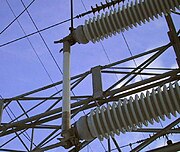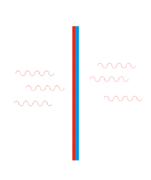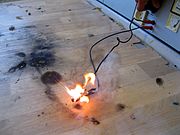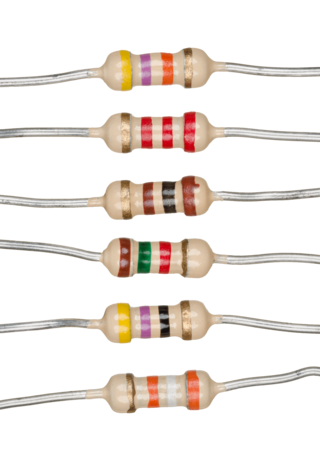
A resistor is a passive two-terminal electrical component that implements electrical resistance as a circuit element. In electronic circuits, resistors are used to reduce current flow, adjust signal levels, to divide voltages, bias active elements, and terminate transmission lines, among other uses. High-power resistors that can dissipate many watts of electrical power as heat may be used as part of motor controls, in power distribution systems, or as test loads for generators. Fixed resistors have resistances that only change slightly with temperature, time or operating voltage. Variable resistors can be used to adjust circuit elements, or as sensing devices for heat, light, humidity, force, or chemical activity.

A thermistor is a semiconductor type of resistor whose resistance is strongly dependent on temperature, more so than in standard resistors. The word thermistor is a portmanteau of thermal and resistor.

The electrical resistance of an object is a measure of its opposition to the flow of electric current. Its reciprocal quantity is electrical conductance, measuring the ease with which an electric current passes. Electrical resistance shares some conceptual parallels with mechanical friction. The SI unit of electrical resistance is the ohm, while electrical conductance is measured in siemens (S).
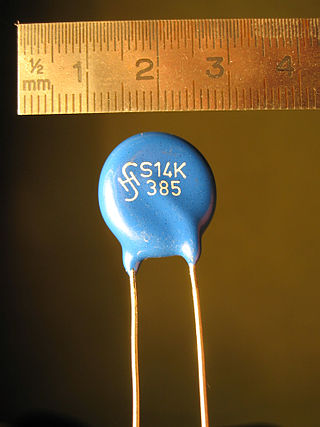
A varistor is a surge protecting electronic component with an electrical resistance that varies with the applied voltage. It has a nonlinear, non-ohmic current–voltage characteristic that is similar to that of a diode. Unlike a diode however, it has the same characteristic for both directions of traversing current. Traditionally, varistors were indeed constructed by connecting two rectifiers, such as the copper-oxide or germanium-oxide rectifier in antiparallel configuration. At low voltage the varistor has a high electrical resistance which decreases as the voltage is raised. Modern varistors are primarily based on sintered ceramic metal-oxide materials which exhibit directional behavior only on a microscopic scale. This type is commonly known as the metal-oxide varistor (MOV).

A power supply is an electrical device that supplies electric power to an electrical load. The main purpose of a power supply is to convert electric current from a source to the correct voltage, current, and frequency to power the load. As a result, power supplies are sometimes referred to as electric power converters. Some power supplies are separate standalone pieces of equipment, while others are built into the load appliances that they power. Examples of the latter include power supplies found in desktop computers and consumer electronics devices. Other functions that power supplies may perform include limiting the current drawn by the load to safe levels, shutting off the current in the event of an electrical fault, power conditioning to prevent electronic noise or voltage surges on the input from reaching the load, power-factor correction, and storing energy so it can continue to power the load in the event of a temporary interruption in the source power.
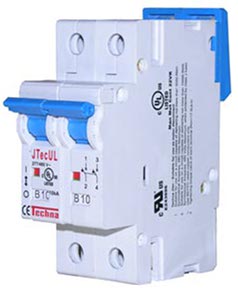
A circuit breaker is an electrical safety device designed to protect an electrical circuit from damage caused by overcurrent. Its basic function is to interrupt current flow to protect equipment and to prevent the risk of fire. Unlike a fuse, which operates once and then must be replaced, a circuit breaker can be reset to resume normal operation.

A thermostat is a regulating device component which senses the temperature of a physical system and performs actions so that the system's temperature is maintained near a desired setpoint.

A surge protector (or spike suppressor, surge suppressor, surge diverter, surge protection device or transient voltage surge suppressor is an appliance or device intended to protect electrical devices in alternating current circuits from voltage spikes, which can arise from a variety of causes including lightning strikes in the vicinity and have a very short duration measured in microseconds.

A bimetallic strip is a strip that consists of two strips of different metals which expand at different rates as they are heated. They are used to convert a temperature change into mechanical displacement. The different expansions force the flat strip to bend one way if heated, and in the opposite direction if cooled below its initial temperature. The metal with the higher coefficient of thermal expansion is on the outer side of the curve when the strip is heated and on the inner side when cooled.

Joule heating is the process by which the passage of an electric current through a conductor produces heat.

In electronics and electrical engineering, a fuse is an electrical safety device that operates to provide overcurrent protection of an electrical circuit. Its essential component is a metal wire or strip that melts when too much current flows through it, thereby stopping or interrupting the current. It is a sacrificial device; once a fuse has operated, it is an open circuit, and must be replaced or rewired, depending on its type.
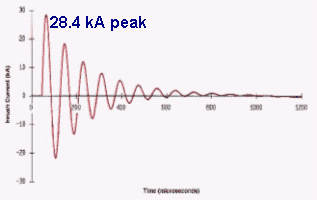
Inrush current, input surge current, or switch-on surge is the maximal instantaneous input current drawn by an electrical device when first turned on. Alternating-current electric motors and transformers may draw several times their normal full-load current when first energized, for a few cycles of the input waveform. Power converters also often have inrush currents much higher than their steady-state currents, due to the charging current of the input capacitance. The selection of over-current-protection devices such as fuses and circuit breakers is made more complicated when high inrush currents must be tolerated. The over-current protection must react quickly to overload or short-circuit faults but must not interrupt the circuit when the inrush current flows.

An electronic component is any basic discrete electronic device or physical entity part of an electronic system used to affect electrons or their associated fields. Electronic components are mostly industrial products, available in a singular form and are not to be confused with electrical elements, which are conceptual abstractions representing idealized electronic components and elements. A datasheet for an electronic component is a technical document that provides detailed information about the component's specifications, characteristics, and performance.

Thermal runaway describes a process that is accelerated by increased temperature, in turn releasing energy that further increases temperature. Thermal runaway occurs in situations where an increase in temperature changes the conditions in a way that causes a further increase in temperature, often leading to a destructive result. It is a kind of uncontrolled positive feedback.

Electric heating is a process in which electrical energy is converted directly to heat energy. Common applications include space heating, cooking, water heating and industrial processes. An electric heater is an electrical device that converts an electric current into heat. The heating element inside every electric heater is an electrical resistor, and works on the principle of Joule heating: an electric current passing through a resistor will convert that electrical energy into heat energy. Most modern electric heating devices use nichrome wire as the active element; the heating element, depicted on the right, uses nichrome wire supported by ceramic insulators.

A fan heater, also called a blow heater, is a heater that works by using a fan to pass air over a heat source. This heats up the air, which then leaves the heater, warming up the surrounding room. They can heat an enclosed space such as a room faster than a heater without a fan, but like any fan, create a degree of noise.

A thermal cutoff is an electrical safety device that interrupts electric current when heated to a specific temperature. These devices may be for one-time use, or may be reset manually or automatically.
An infinite switch, simmerstat, energy regulator or infinite controller is a type of switch that allows variable power output of a heating element of an electric stove. It is called "infinite" because its average output is infinitely variable rather than being limited to a few switched levels. It uses a bi-metallic strip conductive connection across terminals that disconnects with increased temperature. As current passes through the bimetal connection, it will heat and deform, breaking the connection and turning off the power. After a short time, the bimetal will cool and reconnect. Infinite switches vary the average power delivered to a device by switching frequently between on and off states. They may be used for situations that are not sensitive to such changes, such as the resistive heating elements in electric stoves and kilns.

Electronic components have a wide range of failure modes. These can be classified in various ways, such as by time or cause. Failures can be caused by excess temperature, excess current or voltage, ionizing radiation, mechanical shock, stress or impact, and many other causes. In semiconductor devices, problems in the device package may cause failures due to contamination, mechanical stress of the device, or open or short circuits.
A high-resistance connection (HRC) is a hazard that results from loose or poor connections in traditional electrical accessories and switchgear which can cause heat to develop, capable of starting a fire.





